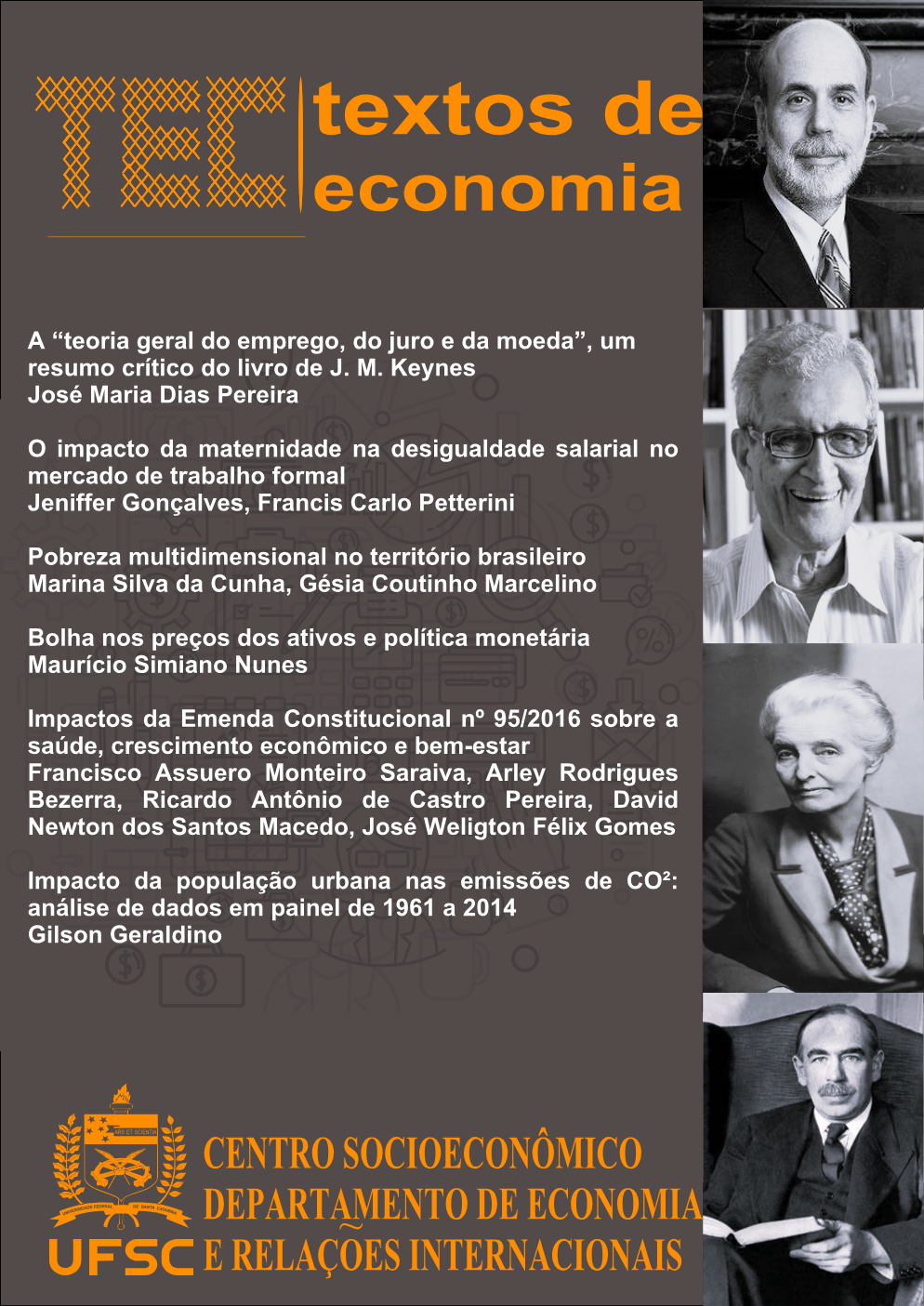Impacto da população urbana nas emissões de CO²: análise de dados em painel de 1961 a 2014
DOI:
https://doi.org/10.5007/2175-8085.2023.e93322Palavras-chave:
Poluição, Meio ambiente, População urbana, Dados em painelResumo
Neste artigo, apresentamos evidências empíricas do impacto do desenvolvimento na poluição, em uma perspectiva de longo prazo, de 1961 a 2014, utilizando dados médios quinquenais de países do Banco Mundial sobre as emissões de CO2 (uma proxy para a poluição), crescimento populacional e população urbana (proxy para a pressão sobre os recursos naturais humanos) e expectativa de vida ao nascer (proxy para o desenvolvimento). Também consideramos os efeitos regionais, níveis de renda e efeitos temporais. Descobrimos que apenas a população urbana possui um efeito positivo e robusto sobre a poluição. Isso faz sentido, uma vez que a população mundial e a concentração urbana aumentaram significativamente no século XX. Essa concentração humana espetacular em uma sociedade baseada em carbono teve um forte impacto no meio ambiente.
Referências
ABADIE, A. Statistical Nonsignificance in Empirical Economics. AER: Insights 2020, 2(2): 193-208
BLOOM, N. The impact of uncertainty shocks. Econometrica, Vol. 77, N.3, p. 623-685, 2009
BORDO, M.D.; LANDON-LANE, J.S. The global financial crisis of 2007-08: is it unprecedented? NBER-WP 16589, 2010. http://www.nber.org/papers/w16589
CARROTHERS, G.A.P. An historical review of the gravity and potential concepts of human interaction. Journal of the American Institute of Planners. V.22, I.2, 1956, p. 94-102
CECCHETTI, S.G.; KOHLER, M.; UPPER, C. Financial crises and economic activity. NBER-WP 15379, 2009. http://www.nber.org/papers/w15379
COMBES, P.; GOBILLON, L. The Empirics of Agglomeration Economies. IN: Duranton, G; Henderson, J.V.; Strange, W.C. (Editors) Handbook of Regional and Urban Economics, Volume 5, p. 248-348. Elsevier, 2015.
FRENKEL, J.A. The environment and globalization. NBER WP 10090. November, 2003.
GREENE, W. Econometric Analysis. 8th Edition, Person, 2018.
HENDERSON, J.V. The sizes and types of cities. Queen's Economics Department Working Paper #75. Queen's University. November, 1972.
KAHN, M.E.; WALSH, R. Cities and the Environment. IN: Duranton, G; Henderson, J.V.; Strange, W.C. (Editors) Handbook of Regional and Urban Economics, Volume 5, p. 406-465. Elsevier, 2015.
KRUGMAN,P. Increasing returns and economic geography. Journal of Politica Economy, V99, N3, p. 483-499.
NORDHAUS, WD; TOBIN, J. Is Growth obsolete? In: NORDHAUS, WD; TOBIN, J. Economic Research: Retrospect and Prospect. NBER, 1972. https://www.nber.org/system/files/chapters/c7620/c7620.pdf
OTTAVIANO, G; THIDE, J. Aglomeration and economic geography. IN:Henderson J.V. ; Thisse, JE. (Editors) Handbook of Regional and Urban Economics, Volume 4, p. 2563-2608. Elsevier, 2004.
PANAYOTOU, T. Empirical Tests and Policy Analysis of Environmental Degradation at Different Stages of Economic Development. World Employment Programme Research. International Labour Office. WP238. Geneva. January, 1993.
STERN, D.I. The Rise and Fall of the Environmental Kuznets Curve. World Development V.32, N.8, p. 1419-1439, 2004.
WORLD BANK. OPEN DATA. https://data.worldbank.org/indicator . Access from 01/25/2021 to 01/27/2021.
Downloads
Publicado
Edição
Seção
Licença
Os Direitos Autorais para artigos publicados neste periódico são do autor. Em virtude de aparecerem nesta revista de acesso público, os artigos são de uso gratuito, com atribuições próprias, em aplicações educacionais, de exercício profissional e para gestão pública. A Revista adotou a licença Creative Commons - Atribuição-NãoComercial-SemDerivações 4.0 Internacional. Esta licença permite acessar, baixar (download), compartilhar o conteúdo dos artigos desde que citada a fonte, atribuindo os devidos créditos de autoria.

Esta obra está licenciada sob uma Licença Creative Commons - Atribuição-NãoComercial-SemDerivações 4.0 Internacional.



